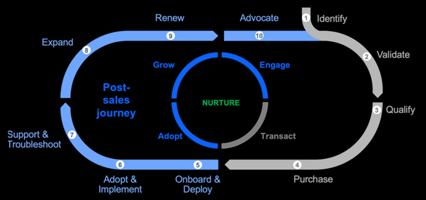The right customer experience will leave the customer grateful as if they've gotten a gift from the...
Making It Stick: Client Success for Sustained Growth Post-Sales

This is a guest post by Syed Danish Irfan. Danish is a leader focused on client success at IBM. He previously shared his holistic understanding of a Client Engagement Model and how to close deals in pre-sales. In this article, he explains the goals and components of post-sales client success.
It costs 5x to acquire a new customer than to sell to an existing customer. This means a business cannot do well unless it ensures the continued satisfaction and success of its existing clients. Post-sales client success is crucial for fostering long-term relationships, ensuring customer satisfaction, and promoting customer loyalty.
In an established tech services firm, dedicated client success teams are essential for executing and managing post-sales initiatives. These teams are responsible for ensuring that clients achieve their desired outcomes and have a positive experience with the company. They act as the primary point of contact for clients, offering guidance, support, and solutions.
This article explores the importance of client success in the post-sales phase and outlines strategies to enhance this critical aspect of business operations.
Why Client Success Teams Are A Win-Win
Imagine you sign up for a gym membership. But after you sign up, they assign a trainer to you. The trainer does an assessment, understands your goals, and creates a plan for you. Your trainer meets up with you regularly, keeps track of your progress, adjusts your long-term goals, and makes sure you know how to use the gym resources.
At contract renewal time, you’re going to be healthier and get an advantage from the gym. Renewal itself is a non-issue. The conversation at renewal time will be at a higher level. Realigning and creating your new goals, trying to see if there are new resources like a nutritionist that can help you. The gym gets far better retention.
But consider it from the client's perspective. The client is not looking for a gym membership. They are looking for better health. The trainer makes sure the client receives good health from the gym rather than access to equipment.
The Role of a Client Success Manager
This analogy shows why the role of Client Success Managers is essential to an emerging tech services firm. The client is not looking for keyboard punchers. The client is looking to implement new technology to fulfill a business need. A Client Success Manager (CSM) is responsible for ensuring that clients achieve their desired outcomes while using a company's products or services. This role is vital in building and maintaining strong client relationships, driving client satisfaction, and ensuring long-term retention and growth.
The CSM serves as the primary point of contact for clients, acting as both an advocate for the client within the company and a representative of the company to the client. They marshall the company's resources to ensure the client’s needs are met.
Client success journey in post-sales
The client success journey is comprised of six key milestones, which are reflected in the image below. Each milestone represents a crucial step in the progression of the client's journey to foster a long-term relationship.

-
Onboarding and Training: Effective onboarding is the foundation of post-sales client success. Providing comprehensive training and resources helps clients understand how to use the product or service to its fullest potential. This initial engagement sets the tone for a positive ongoing relationship.
-
Adoption/ Proactive Engagement: Regular check-ins and proactive communication demonstrate that the company values its clients and is committed to their success. These interactions provide opportunities to gather feedback, address concerns, and offer additional support or resources.
-
Value Realization and Personalized Support: Personalized support goes beyond generic customer service. Tailoring interactions and solutions to meet the specific needs and goals of individual clients can significantly enhance their satisfaction and success. This approach requires a deep understanding of each client's business and unique challenges.
-
Retention/ Renewal: As the client starts to realize the value of their investment with an organization, renewal becomes a “non-event”. Customer retention is significantly more cost-effective than acquiring new clients. According to research, acquiring a new client can cost five times more than retaining an existing one. Post-sales client success initiatives ensure that clients continue to find value in the products or services they have purchased, thereby increasing their likelihood of staying loyal to the brand.
-
Expansion: Happy and successful clients are more likely to make repeat purchases, upgrade their services, or buy additional products. This increases the lifetime value of a customer, contributing to steady revenue growth. Moreover, satisfied clients often become brand advocates, providing valuable referrals and word-of-mouth marketing.
-
Advocacy: Nurturing an existing client is about “walking the journey with them every step in the way”. It involves understanding the client's perspective, ensuring their voice is heard, and acting as their champion to improve their experience and satisfaction with the company's products or services. Client advocacy aims to build strong, trusting relationships between the client and the company, ultimately driving client success and retention.
Measure of Success for CSMs:
Businesses must establish clear metrics and KPIs to gauge the effectiveness of post-sales client success efforts. Common metrics include customer satisfaction scores (CSAT), Net Promoter Score (NPS), customer retention rate, and churn rate. Regularly analyzing these metrics helps identify areas for improvement and measure the impact of client success initiatives.
Wrapping Up
Client success in the post-sales phase is a critical driver of business growth, client loyalty, and competitive advantage. By prioritizing effective onboarding, proactive engagement, personalized support, and leveraging technology, companies can ensure their clients achieve success and satisfaction with their products or services.
Investing in post-sales client success not only reduces churn and increases revenue but also fosters a strong, positive brand reputation that attracts new clients and retains existing ones. Not building a proper CSM function is a disservice to your business and your clients.
Connect with me on LinkedIn to learn more about the process and value of CSMs in a technical services organization.





